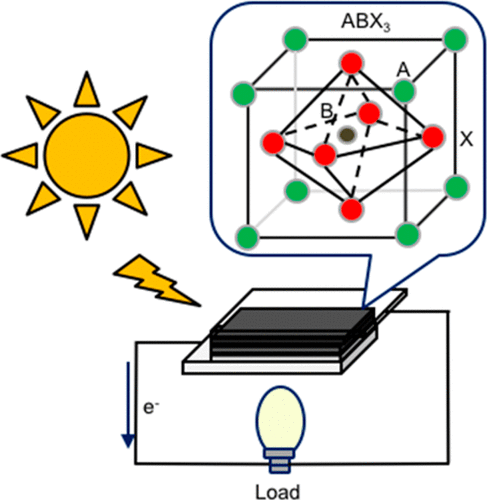当前位置:
X-MOL 学术
›
J. Chem. Educ.
›
论文详情
Our official English website, www.x-mol.net, welcomes your
feedback! (Note: you will need to create a separate account there.)
Fabrication and Characterization of Perovskite Solar Cells: An Integrated Laboratory Experience
Journal of Chemical Education ( IF 2.5 ) Pub Date : 2018-01-09 00:00:00 , DOI: 10.1021/acs.jchemed.7b00299 Vivien L. Cherrette 1 , Connor J. Hutcherson 1 , Jeremy L. Barnett 1 , Monica C. So 1
Journal of Chemical Education ( IF 2.5 ) Pub Date : 2018-01-09 00:00:00 , DOI: 10.1021/acs.jchemed.7b00299 Vivien L. Cherrette 1 , Connor J. Hutcherson 1 , Jeremy L. Barnett 1 , Monica C. So 1
Affiliation

|
Perovskite solar cells have garnered exponential research interest due to their facile fabrication, solution processability, and low cost. However, there have been limited efforts to integrate this class of materials into the undergraduate laboratory curriculum. Therefore, we designed an integrated laboratory experiment in our upper-division integrated laboratory sequence to teach students about research procedures and tools used in physical, organic, inorganic, and materials chemistry. This laboratory sequence involves conversion of sunlight to electricity, which is one of the most challenging renewable energy issues we are facing as a society. In this work, upper-level undergraduates study four variables affecting the morphology and optical properties of perovskites: solvent treatment, percent of water added to a precursor mixture, cation substitution, and precursor temperature. To do so, students deposit uniform films of the material using spin-coating and annealing, and then probe the resulting film properties via scanning electron microscopy, X-ray diffraction, solid-state UV–vis spectroscopy, and current–voltage measurements. Students are able to execute the simple experimental setups and critically interpret, and compare, their results. Further, students are asked to question and understand structure–property relationships to arrive at a fuller understanding of the light-to-electricity conversion process. Importantly, this laboratory prepares students for cutting-edge inorganic and materials research topics.
中文翻译:

钙钛矿太阳能电池的制造与表征:综合实验室经验
钙钛矿太阳能电池因其制造简便,溶液可加工性和成本低廉而赢得了指数研究兴趣。但是,将此类材料整合到本科实验室课程中的工作很少。因此,我们按照上级综合实验室的顺序设计了一个综合实验室实验,以教授学生有关物理,有机,无机和材料化学的研究程序和工具。这个实验室过程涉及将阳光转化为电能,这是我们社会面临的最具挑战性的可再生能源问题之一。在这项工作中,高年级本科生研究了影响钙钛矿形态和光学特性的四个变量:溶剂处理,加到前体混合物中的水百分比,阳离子取代和前驱体温度。为此,学生可以使用旋涂和退火方法沉积均匀的材料膜,然后通过扫描电子显微镜,X射线衍射,固态紫外可见光谱和电流电压测量来探测所得膜的性质。学生能够执行简单的实验设置,并批判性地解释和比较他们的结果。此外,还要求学生质疑和理解结构与属性之间的关系,以便对光-电转换过程有更全面的了解。重要的是,该实验室为学生准备了前沿的无机和材料研究主题。然后通过扫描电子显微镜,X射线衍射,固态紫外可见光谱和电流电压测量来探测所得膜的性质。学生能够执行简单的实验设置,并批判性地解释和比较他们的结果。此外,还要求学生质疑和理解结构与属性之间的关系,以便对光-电转换过程有更全面的了解。重要的是,该实验室为学生准备了前沿的无机和材料研究主题。然后通过扫描电子显微镜,X射线衍射,固态紫外可见光谱和电流电压测量来探测所得膜的性质。学生能够执行简单的实验设置,并批判性地解释和比较他们的结果。此外,还要求学生质疑和理解结构与属性之间的关系,以便对光-电转换过程有更全面的了解。重要的是,该实验室为学生准备了前沿的无机和材料研究主题。要求学生提问和理解结构与属性之间的关系,以便对光电转换过程有更全面的了解。重要的是,该实验室为学生准备了前沿的无机和材料研究主题。要求学生提问和理解结构与属性之间的关系,以便对光电转换过程有更全面的了解。重要的是,该实验室为学生准备了前沿的无机和材料研究主题。
更新日期:2018-01-09
中文翻译:

钙钛矿太阳能电池的制造与表征:综合实验室经验
钙钛矿太阳能电池因其制造简便,溶液可加工性和成本低廉而赢得了指数研究兴趣。但是,将此类材料整合到本科实验室课程中的工作很少。因此,我们按照上级综合实验室的顺序设计了一个综合实验室实验,以教授学生有关物理,有机,无机和材料化学的研究程序和工具。这个实验室过程涉及将阳光转化为电能,这是我们社会面临的最具挑战性的可再生能源问题之一。在这项工作中,高年级本科生研究了影响钙钛矿形态和光学特性的四个变量:溶剂处理,加到前体混合物中的水百分比,阳离子取代和前驱体温度。为此,学生可以使用旋涂和退火方法沉积均匀的材料膜,然后通过扫描电子显微镜,X射线衍射,固态紫外可见光谱和电流电压测量来探测所得膜的性质。学生能够执行简单的实验设置,并批判性地解释和比较他们的结果。此外,还要求学生质疑和理解结构与属性之间的关系,以便对光-电转换过程有更全面的了解。重要的是,该实验室为学生准备了前沿的无机和材料研究主题。然后通过扫描电子显微镜,X射线衍射,固态紫外可见光谱和电流电压测量来探测所得膜的性质。学生能够执行简单的实验设置,并批判性地解释和比较他们的结果。此外,还要求学生质疑和理解结构与属性之间的关系,以便对光-电转换过程有更全面的了解。重要的是,该实验室为学生准备了前沿的无机和材料研究主题。然后通过扫描电子显微镜,X射线衍射,固态紫外可见光谱和电流电压测量来探测所得膜的性质。学生能够执行简单的实验设置,并批判性地解释和比较他们的结果。此外,还要求学生质疑和理解结构与属性之间的关系,以便对光-电转换过程有更全面的了解。重要的是,该实验室为学生准备了前沿的无机和材料研究主题。要求学生提问和理解结构与属性之间的关系,以便对光电转换过程有更全面的了解。重要的是,该实验室为学生准备了前沿的无机和材料研究主题。要求学生提问和理解结构与属性之间的关系,以便对光电转换过程有更全面的了解。重要的是,该实验室为学生准备了前沿的无机和材料研究主题。











































 京公网安备 11010802027423号
京公网安备 11010802027423号